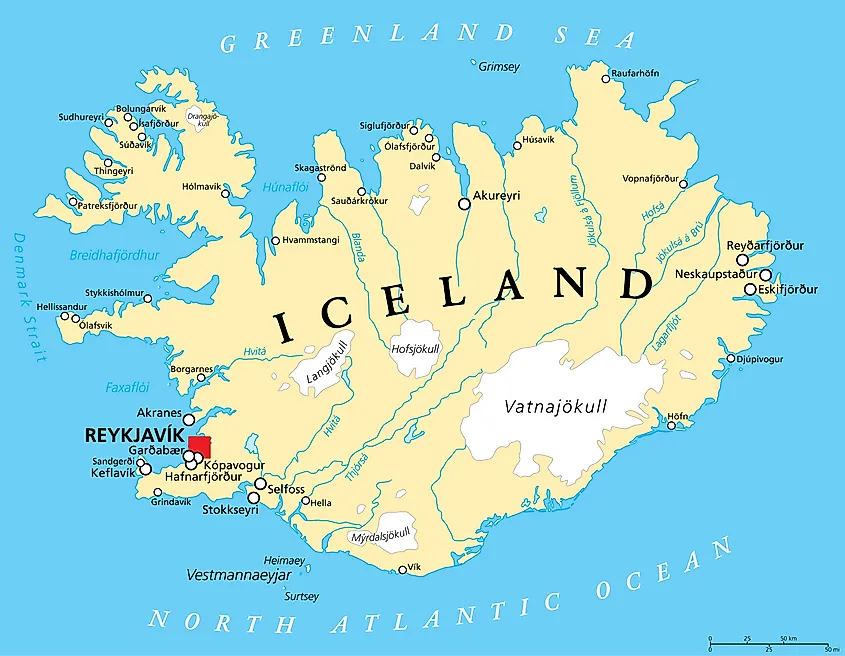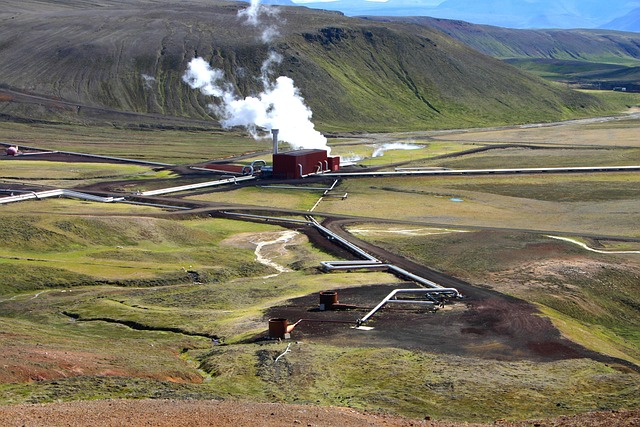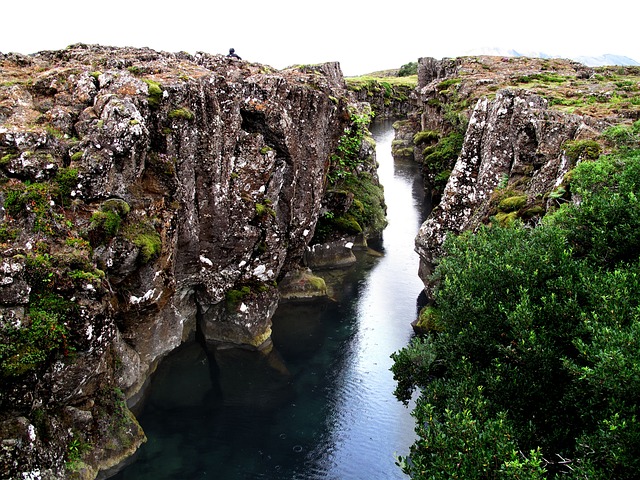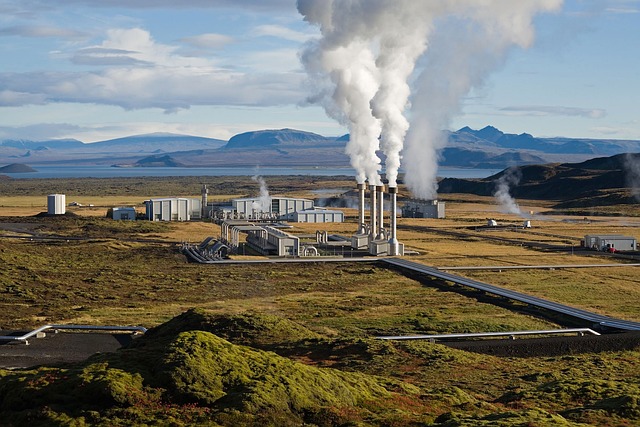Iceland
Grades 7+
 Feel the ground or the floor under you. Think of it as part of a continent. Feels solid, doesn’t it.
Feel the ground or the floor under you. Think of it as part of a continent. Feels solid, doesn’t it.
Except it’s not.
The Earth’s crust and mantle are composed of gigantic tectonic plates. The plates “float” on the Earth’s outer core. They slowly collide or separate. Sometimes, one plate slides under the other, that takes tens of millions of years. Or if they hit like two bulls engaged in a combat in an unimaginable slow-motion, during which they form mountains – raging as earthquakes in the process. In other cases, they separate, which creates valleys – both on land in under the oceans – called rifts.
Iceland Activity 1
Cut out the continents from a map. Play with them, and you will see they fit together.
 At one time all seven were one continent, which we call Pangea. Then they slowly and steadily drifted apart, inch by inch, in a process we call continental drift. You can witness that here:
At one time all seven were one continent, which we call Pangea. Then they slowly and steadily drifted apart, inch by inch, in a process we call continental drift. You can witness that here:
Which brings us to me.
I am Iceland, born from that massive tearing of the world. I am an island straddling two tectonic plates, the American and the Eurasian plates. I owe my unique landscape to that unique position.
Compared to other lands in the world, I am relatively young. I began to form about 20 million years ago. The Earth itself is 4.5 billion years old. At first, there were volcanoes that came out of the ocean. Then, from eruption to another, they ended up shaping me. I am full of sumptuous landscapes resulting from the battle between the forces of nature. A battle between water, fire, and ice that has been raging for millions of years.
On the mention of ice, my name may sometimes get confused with Greenland. But here is a trick to make us apart: Greenland is mainly icy, while Iceland is mainly green.
 In Pingvellir National Park, you can see the tectonic plates at play. You will see the mid-ocean ridge on land. Pieces of bedrock have broken off from one continent and moved into another one. The rift valley of the Mid-Atlantic Ridge runs through me and through much of Europe and Africa. was formed over millions of years by the sea floor spreading apart along a global tectonic plate boundary. It is still active, with lava flowing every few years.
In Pingvellir National Park, you can see the tectonic plates at play. You will see the mid-ocean ridge on land. Pieces of bedrock have broken off from one continent and moved into another one. The rift valley of the Mid-Atlantic Ridge runs through me and through much of Europe and Africa. was formed over millions of years by the sea floor spreading apart along a global tectonic plate boundary. It is still active, with lava flowing every few years.
I am aptly called the “Land of Fire and Ice.” I am at the edge of the Arctic Circle. I have over two hundred volcanoes, along with many geysers and hot springs. Iceland is also the land of Vikings, glaciers, and erupting volcanoes. There’s a good reason why Jules Verne chose me as the starting point for his novel Journey to the Center of Earth.
With only nine people per square mile, I am the least densely populated country in Europe.* Most people live on a narrow coastal strip, in the valleys, and on the plains. My greatest concentration of people, though, are in Reykjavík (Ray-ka-vik), the capital.
Here, in the middle of the North Atlantic, you are far away from other major landmasses. That position has profoundly affected my humans and their culture.
- It’s made them tough from surviving in a harsh environment. The winters are long and cold, the landscape mostly barren and desolate. Despite those conditions, Icelanders have thrived.
- It’s made them creative. With little access to the outside world, Icelanders have had to be resourceful. They have developed music, cuisine, and art that have become popular throughout Scandinavia.
- It’s made them welcoming. Because Icelanders have had to rely on each other, they’ve developed a strong sense of community and a wonderful hospitality towards strangers.
♦
 One example of Icelanders’ creativity is their power-generation and use. Water is the most abundant and valuable natural resource in Iceland, and Icelanders make good use of this godsend. Geothermal power makes up around two-thirds of Iceland’s electricity production. In Reykjavík, nine out of ten homes are heated thanks to this renewable energy source. All of which this makes them proud of me.
One example of Icelanders’ creativity is their power-generation and use. Water is the most abundant and valuable natural resource in Iceland, and Icelanders make good use of this godsend. Geothermal power makes up around two-thirds of Iceland’s electricity production. In Reykjavík, nine out of ten homes are heated thanks to this renewable energy source. All of which this makes them proud of me.
That geothermal activity also results in many hot springs. That’s especially true in Landmannalaugar, the region in the south. It is home to many “People’s Pools,” used for centuries as a source of drinking water and bathing. Landmannalaugar’s pools are naturally heated to around 104 degrees Fahrenheit (40 degrees Celsius). This water is rich in minerals such as sulfur and iron. Because of its healing properties, many Icelanders come here to soak and relax in the pools.
If all I told you so far still doesn’t make you interested in me, then my midnight sun and aurora borealis might.
The midnight sun is a unique phenomenon in which, during certain months, the sun does not set below the horizon for several days. This event occurs due to my high northern location, resulting in long periods of daylight throughout summer. You can play baseball at midnight if you wish. During winter, you can have an aurora party – you and your friends can watch beautiful green, pink, and purple hues of the Northern Lights dance and swirl across my night sky.
_______
*Greenland has far fewer people per square mile but is considered part of North America.
Iceland Activity 2
Use the noun and verb tests to determine which of the following are nouns and which are verbs.
Noun tests Verb tests
The ___________ OR The __________ named ___________. Sbe _______. They ____________.
1. drifted | 3. continents | 5. aurora | 7. activity | 9. Pangea |
2. owe | 4.is | 6. occurs | 8. composed | 10. island |
Iceland Activity 3
Use the noun and verb tests to determine which of the following are nouns, which are verbs, which are both, and which are neither.
Noun tests Verb tests
The ___________ OR The _______ named ____________. She ____________. They ____________
1. icy | 3. lands | 5. water | 7. reason | 9. iron | 11. sun | 13. baseball | 15. rely |
2. mention | 4.grounds | 6. my | 8. music | 10. strangers | 12. set | 14. summer | 16. power |
Iceland Activity 4
Look at the words in Activity 2 that can be both nouns and verbs. Find the words in the essay. Is the word used as a noun or as a verb?
Optional Activity
Want a chance to have your writing published on this website – and possibly win $500?
Then choose a subject from this list. Write an essay of 200-500 words. Follow the directions exactly. It is best if you do this activity as a class.
All students submitting an essay will receive a Certificate of Completion from Dr. George Guthridge.
Teachers and Parents:
Want a chance to have your students’ writing published on this website – and possibly win an additional $500 for your classroom?
Have your students choose a subject from this list. Write an essay of 200-500 words. Follow the directions exactly. It is best if you do this activity as a class. Then, as teacher, add an exercise. Make sure you approach nouns as this website does and not as traditional grammar does.
You can make an exercise like the one here, or you can develop an exercise of your own. The more creative and effective your exercise is, the better your chance to win the prize.
Note: You do not have to do this part of the process. Your students can submit an essay without it.